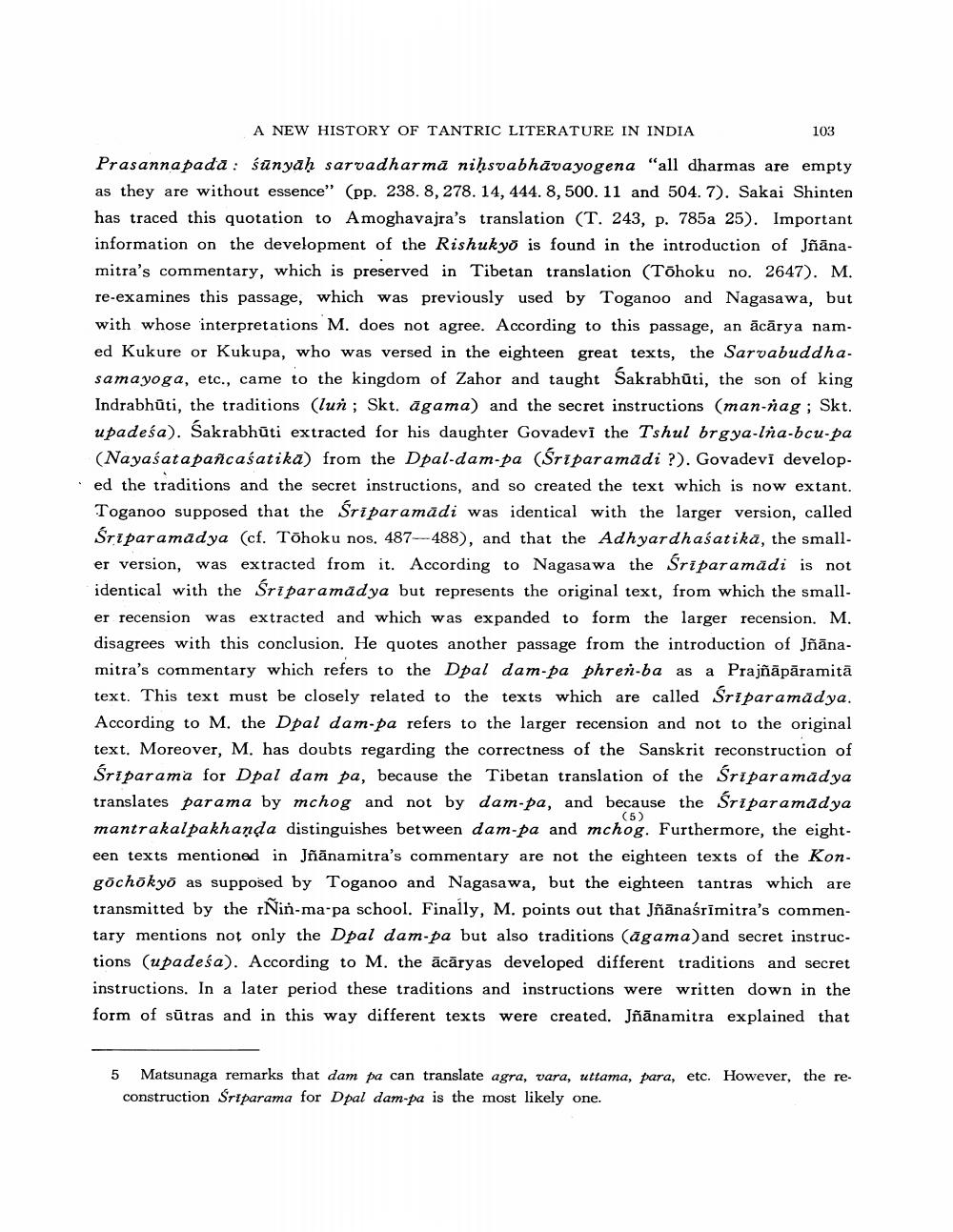________________
103
A NEW HISTORY OF TANTRIC LITERATURE IN INDIA Prasanna pada : śūnyaḥ sarvadhar mā niņsvabhāvayogena "all dharmas are empty as they are without essence" (pp. 238. 8, 278. 14, 444. 8,500.11 and 504.7). Sakai Shinten has traced this quotation to Amoghavajra's translation (T. 243, p. 785a 25). Important information on the development of the Rishukyo is found in the introduction of Jñānamitra's commentary, which is preserved in Tibetan translation (Tōhoku no. 2647). M. re-examines this passage, which was previously used by Toganoo and Nagasawa, but with whose interpretations M. does not agree. According to this passage, an ācārya named Kukure or Kukupa, who was versed in the eighteen great texts, the Sarvabuddhasamayoga, etc., came to the kingdom of Zahor and taught Sakrabhūti, the son of king Indrabhūti, the traditions (lun ; Skt. āgama) and the secret instructions (man-nag; Skt. upadeśa). Sakrabhūti extracted for his daughter Govadevi the Tshul brgya-Ina-bcu-pa (Nayaśata pañcaśatika) from the Dpal-dam-pa (Śriparamādi ?). Govadevī developed the traditions and the secret instructions, and so created the text which is now extant. Toganoo supposed that the Sriparamādi was identical with the larger version, called Śriparamadya (cf. Tōhoku nos. 487---488), and that the Adhyardhaśatikā, the smaller version, was extracted from it. According to Nagasawa the Sriparamādi is not identical with the Sriparamadya but represents the original text, from which the smaller recension was extracted and which was expanded to form the larger recension. M. disagrees with this conclusion. He quotes another passage from the introduction of Jñānamitra's commentary which refers to the Dpal dam-pa phren-ba as a Prajñāpāramitā text. This text must be closely related to the texts which are called Sriparamădya. According to M. the Dpal dam-pa refers to the larger recension and not to the original text. Moreover, M. has doubts regarding the correctness of the Sanskrit reconstruction of Śriparama for Dpal dam pa, because the Tibetan translation of the Sriparamadya translates parama by mchog and not by dam-pa, and because the Sriparamadya mantrakalpakhanda distinguishes between dam-pa and mchog. Furthermore, the eighteen texts mentioned in Jñānamitra's commentary are not the eighteen texts of the Kongochōkyō as supposed by Toganoo and Nagasawa, but the eighteen tantras which are transmitted by the rÑin-ma-pa school. Finally, M. points out that Jñānaśrīmitra's commentary mentions not only the Dpal dam-pa but also traditions (agama)and secret instructions (upadeśa). According to M. the ācāryas developed different traditions and secret instructions. In a later period these traditions and instructions were written down in the form of sūtras and in this way different texts were created. Jñānamitra explained that
5 Matsunaga remarks that dam pa can translate agra, vara, uttama, para, etc. However, the reconstruction Sriparama for Dpal dam-pa is the most likely one.




